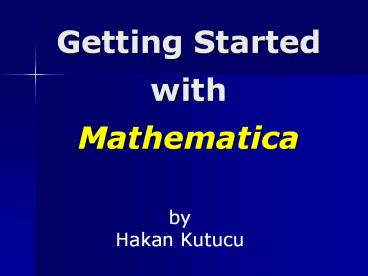Getting Started with Mathematica - PowerPoint PPT Presentation
1 / 32
Title:
Getting Started with Mathematica
Description:
Getting Started with Mathematica. by. Hakan Kutucu. What is Mathematica ... Mathematica is a powerful desktop computer program capable of doing algebraic ... – PowerPoint PPT presentation
Number of Views:124
Avg rating:3.0/5.0
Title: Getting Started with Mathematica
1
Getting Started with Mathematica
by Hakan Kutucu
2
What is Mathematica
- Mathematica is a computer program created by
Wolfram Research Inc.(1988) - Mathematica is a powerful desktop computer
program capable of doing algebraic calculations,
numerical approximations, and computer graphics. - It is suitable for both numeric and symbolic
work, and it has remarkable word-processing
capabilities as well.
3
Some Graphical Examples
4
What is Mathematica
- Mathematica has two parts the Kernel and the
Front End. - The Kernel is the main part of the system, which
accepts Mathematica commands, processes them and
sends back results. This is called evaluating the
command. - The Front End is the part of the system that
handles such things as screen display, printing
and the creation of Mathematica documents.
5
How does Mathematica work?
Mathematica documents are called Notebooks. A
Notebook is a bit like a word-processor document
you can type and edit commands, send them to the
Kernel for evaluation, display the results and
save your work.
6
How does Mathematica work?
- You send commands to be evaluated by holding
down the shift key and pressing the enter key - Another easy way to evaluate by pressing the
enter key at the right hand side of keyboard.
7
Functionalities of Mathematica
- Numerical Computation
- Equation Solving
- Symbolic calculation
- Calculus
- Graphics
- Self-defined functions
- List
- Pattern Matching
- Animation
8
Mathematica Syntax
- Mathematica commands start with a CAPITAL
letter, e.g. Sinx. If the command is really
severalwords in English joined together then each
one starts with a capital but WithNoSpacesInBetwee
n. - Case Sensitive the word Fun is different from
the word fun which is different from the word
fuN.
9
Mathematica Syntax
- Mathematica uses a lot of brackets and all the
different sorts of them, ( ). - Arguments of functions are given in square
brackets . - Curly brackets, called braces, are used to
make a list, usually to allow several objects to
be treated as one. - Expression are cascaded by () pairs.
10
SPECIAL CONSTANTS
Mathematica protects these names they cannot be
used as names for other quantities.
11
Arithmetic Operations
12
Arithmetic Operations
Order of operation is important . BEDMAS
13
N (Numerical)
- (a) Nexpr displays 6 digits by default
- (b) Nexpr, n displays 6 digits when nlt16
- (c) Nexpr, n does not display more digits than
n originally has.
14
Some Mathematical Functions
15
Graphics
Mathematica incorporates a wide range of two-and
three-dimensional graphics functions. The
simplest is Plot, which generates two-dimensional
Cartesian graphs
Plotf, x, xmin, xmax generates a plot of f
as a function of x from xmin to xmax. Plotf1,
f2, , x, xmin, xmax plots several
functions fi.
16
Graphics (Example)
17
Graphics(Options)
18
Graphics(Options)
For Other Options the command is OptionsPlot
19
3 Dimensional Plotting
Plot3D f, x,xmin,xmax, y,ymin,ymax will
draw the graph of z f(x,y) over the rectangle
xmin,xmaxymin,ymax in the xy-plane.
20
3 Dimensional Plotting(Options)
21
Three Dimensional Plotting(Options)
22
Defining Functions
- A function may return a symbol, a real number, a
complex matrix, another function.... - Any mathematical object is an acceptable value
for a function. - A function may be written using mathematical
notation, it may be created using programming
constructs (like for, if/then, etc.), or it could
even be written in another language entirely
(Fortran, C, etc.).
23
Function Variable Names
- Mathematica variable names can be long, but they
must not begin with a number, - Because Mathematica interprets, say, 2dimension
as 2 dimension. - Names can end with a number, though x1 is a
useful way of writing in Mathematica a
subscripted variable like x1. - Note also that combinations of letters without
spaces are interpreted as new variables ax does
not mean ax.
24
Defining Functions
A function can be defined by using the following
form fx_ an expression involving x (no
underbar) Example fx_x23x f4 fa1 ?f
(This shows the definition you made for f. )
25
Equation solving
- Use Solve to solve an equation with an exact
solution, including a symbolic solution. - Use NSolve or FindRoot to obtain a numerical
approximation to the solution. - To use solutions need to use expr/ .x y.
26
Matrix Defining
- Entering a matrix
- a1,2,3,4,5,6,7,8,9
- Displays nicely only if told to
27
Menus exist but are harder to use than typing
28
Matrix Operations
29
Matrix Operations (Multiplication)
Matrix multiplication (also called dot or inner
product) is carried out in Mathematica with the
function Dot, typically entered with a dot
short-hand syntax.
30
Matrix Operations (Transpose)
31
Matrix Operations (Inverse)
32
Matrix Operations Exercises
- By using Solve Commabd
- By using The equation Axb































